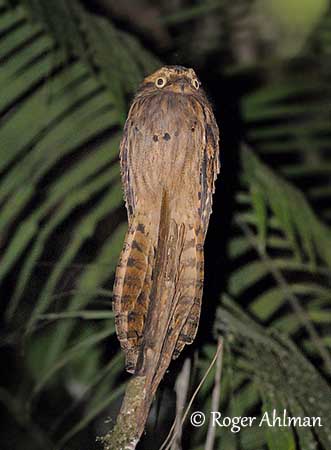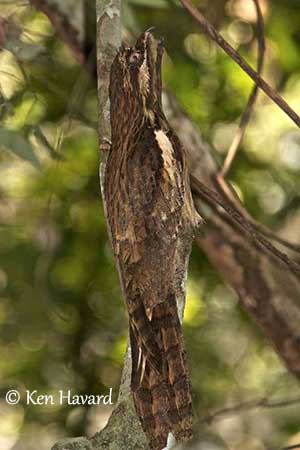
Fr: Ibijau à longue queue
Ang: Long-tailed Potoo
All: Langschwanz-Tagschläfer
Esp: Biemparado Rabilargo, Nictibio Colilargo, Urutaú cola larga, Urutaú Coludo
Ita: Nittibio codalunga
Nd: Wigstaartreuzennachtzwaluw
Sd: långstjärtad poto
Port (Brazil): Mãe-da-lua-parda
Photographers:
Roger Ahlman
Pbase Galleries Peru and Ecuador
Ken Havard
My Bird Gallery & Flickr gallery 1 & Flickr gallery 2
Patrick Ingremau
TAMANDUA
Text by Nicole Bouglouan
Sources:
HANDBOOK OF THE BIRDS OF THE WORLD Vol 5 by Josep del Hoyo-Andrew Elliott-Jordi Sargatal - Lynx Edicions - ISBN: 8487334253
NIGHTJARS - A Guide to Nightjars and Related Nightbirds – Nigel Cleere and Dave Nurney - Yale University Press - First Edition (August 11, 1998) - ISBN 10: 0300074573 / ISBN 13: 9780300074574
A GUIDE TO THE BIRDS OF COLOMBIA by Steven L. Hilty and William L. Brown - Princeton University Press – ISBN 069108372X
BirdLife International (BirdLife International)
Neotropical Birds – Cornell Lab of Ornithology
Wikipedia, the free encyclopaedia
A new identification feature for Long-tailed Potoo (Nyctibius aethereus) by Lee Dingain
The Evolution and Use of the Aftershaft in Birds - Hubert Lyman Clark
Long-tailed Potoo
Nyctibius aethereus
Caprimulgiformes Order – Nyctibiidae Family
INTRODUCTION:
The Long-tailed Potoo is a rarely seen bird patchily distributed throughout N and S Amazon Basin, and some other isolated ranges in northern South America.
Like other potoos, its secretive habits and its cryptic plumage make this bird hard to find. However, it is often detected by its voice, very different from that of other Nyctibius species. Three subspecies are currently recognized.
DESCRIPTION OF THE BIRD:
Biometrics:
Length: 46-56 cm
Weight: 280-447 g
The adult has mainly deep rufous-brown plumage overall, streaked, spotted and marbled blackish on both upperparts and underparts. There is often a conspicuous whitish to buffy shoulder patch. The underparts are slightly paler with a few large, blackish spots on mid-breast. The long graduated rufous-buff tail shows 7-8 conspicuous broad, dark brown bands. The flight feathers are barred pale buff.

On the head, we can see a whitish moustachial stripe contrasting with the blackish lower cheeks. The short bill is blackish. The eyes are greenish-chestnut to bluish-grey, or yellowish-grey. Legs and feet are brownish.
Male and female are similar.
The juvenile resembles adults, but with paler plumage often washed pale cinnamon.
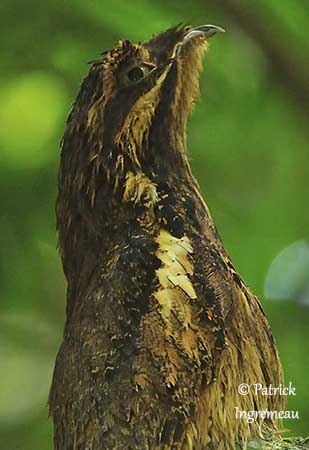
In the nominate race N.a. aethereus, the feathers of scapulars, greater wing-coverts, tertials and mantle (to lesser extent) have sharply upturned tips. This function remains to be elucidated. But this feature appears to be more frequent in the nominate subspecies from the Atlantic Forest, whereas other races may also have this feature but to lesser extent.
However, and this is my own opinion, these upturned tips may be useful during the flight. As this bird often pursues flying insects in acrobatic fashion among dense vegetation, this peculiar feature may help the bird for better manoeuvrability while flying within the forest.
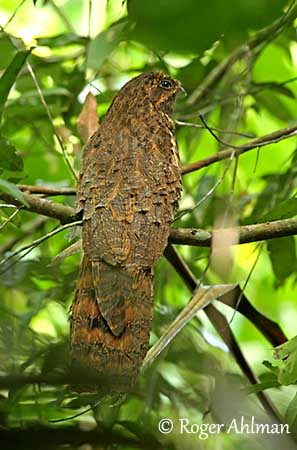
N.a. longicaudatus
The upturned tips are well visible on this picture
SUBSPECIES AND RANGE:
The Long-tailed Potoo has three subspecies.
The nominate race N.a. aethereus (described above) is often called Large-tailed Potoo. It is found in the Atlantic Forest of SE Brazil, in N Brazil, NE Argentina (NE Misiones), and S Paraguay.
N.a. longicaudatus occurs in SE Colombia (Vaupés), E Venezuela (NE Bolivar), Guyana where it is rare, W and N Brazil (Amazonas E to Pará), E Ecuador, N and E Peru (Amazonas and Madre de Dios), and NE Bolivia (NE Santa Cruz).
This race is smaller and often tawnier-brown, mainly on breast, than nominate.
N.a. chocoensis is found in W Colombia (S Chocó, Valle, Cauca and C Nariño).
This one resembles “longicaudatus”, but it has darker upperparts, more chestnut-brown with stronger blackish streaking.
HABITAT:
The Long-tailed Potoo frequents the interior of lowland forests, from humid to relatively dry forests and gallery forests. It also frequents forest edges. It occurs from the understorey to the subcanopy.
In the Atlantic Forest, it usually occurs between sea-level and 500 metres of elevation, sometimes higher, up to 1100 metres, and even to 1325 metres in SE Peru.
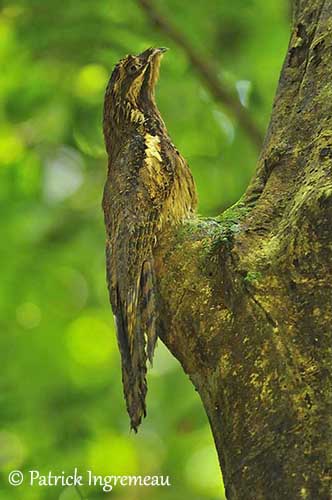
N.a. longicaudatus
Incubating adult
CALLS AND SONGS: SOUNDS BY XENO-CANTO
The Long-tailed Potoo utters a plaintive, almost human “waa-OO-uh” usually repeated at 3/10 seconds intervals. This song is often given at night, around the full moon period.
The song starts with a series of muffled notes “ow ow aOW raOW rahOOL…”
While flying or prior to landing, it gives a series of short “woof” notes. At dawn, we can hear a harsh series of clucking notes.
The Long-tailed Potoo sings from perches within the forest canopy and mainly at night.
BEHAVIOUR IN THE WILD:
Like other Nyctibiidae species, the Long-tailed Potoo feeds on flying insects. The contents of one stomach included flying termites, moths and beetles (Elateridae).
It forages at night by short, acrobatic sallies inside the forest. However, it is clumsy and appears over-sized with its large wings and long tail. While foraging for flying termites in the understorey, it makes short sallies and turns abruptly to return to the same perch. It may also twist abruptly and change direction during the pursuits.
An observer said that the Potoo never even brushed its large wings or tail against the crowded vegetation or made a single sound.
The Long-tailed Potoo is a nocturnal species. During the day, it remains motionless on dead branches in the canopy, up to 20 metres or more above the ground. But it may sometimes perch close to the ground on tree-stumps and out in the open.
While roosting, the bird sits with the tail against the perch. If threatened, it adopts another posture, stretching up neck and head with the bill pointed upwards. It remains motionless until the danger had passed.
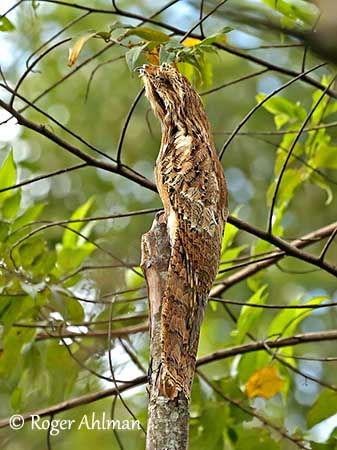
The Long-tailed Potoo is probably monogamous as the pair maintains the territory for long time, involving long-term pair-bonds. Both parents share all the nesting duties.
This species is sedentary.
The flight is silent. The large wings help the bird to rise easily. In direct flight or glide, the long tail is held closed. The tail is spread only on landing or when the bird changes direction while pursuing a prey. It often glides on flat wings with the tips held slightly downwards for more silent flight.
REPRODUCTION OF THIS SPECIES:
The breeding season occurs from August to November in Paraguay. There is no more information from other countries, but this period probably occurs between the late dry season and the early wet season. In French Guiana, the breeding season takes place between early July and late September.
The Long-tailed Potoo does not build a nest, and the female lays a single egg in a shallow depression at top of vertical tree-stump or broken stump, or knot-hole of tree or at the bend of a sloping branch. The same nest-site is reused in several following years.
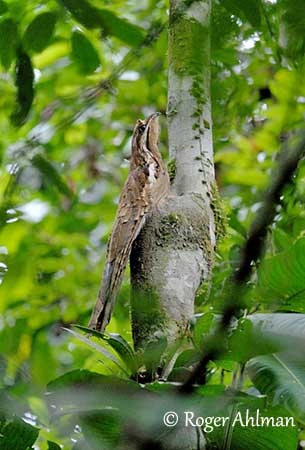
N.a. longicaudatus
Incubating adult
The chick is brooded by the adults. The adult sits behind the chick while it is facing outwards from beneath the feathers of the adult’s belly. At hatching, it has whitish down, greyish eyes, pale bill and legs. It is able to assume the alarm posture of the adults if threatened. Both parents feed it by regurgitation.
Incubation and fledging periods are unknown, but the incubation can last at least one month, and the fledging period is about two months more after hatching.
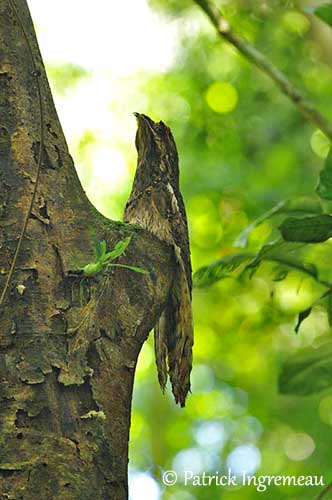
N.a. longicaudatus
Incubating adult
PROTECTION / THREATS / STATUS:
The Long-tailed Potoo is rare throughout the range. The nominate race is probably threatened by deforestation in the Atlantic Forest, but the species is not globally threatened as long as there is extensive primary forest.
The race “chocoensis” has restricted range, but the status is unknown.
The size of the population has not been quantified, and this species is usually uncommon and patchily distributed. The numbers are suspected to be decreasing.
However, the Long-tailed Potoo is currently evaluated as Least Concern.
